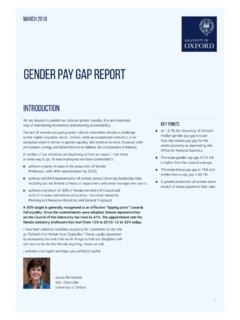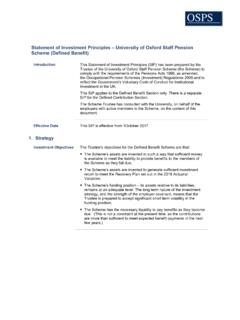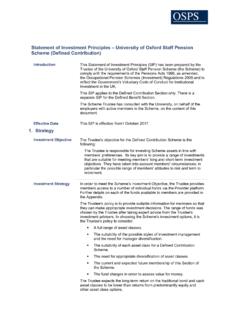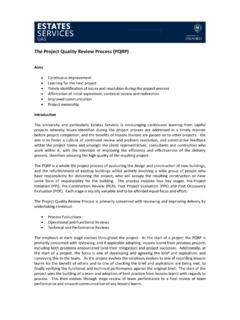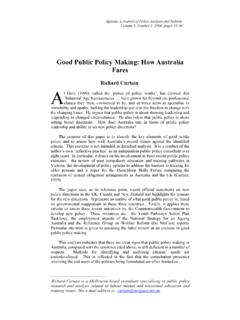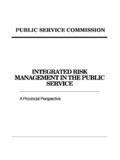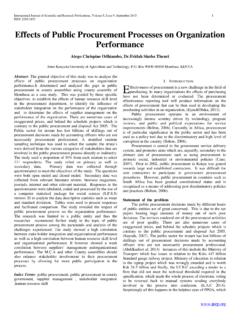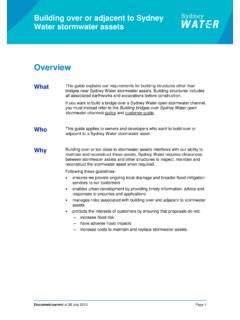Transcription of The Key Performance Indicator Evaluation Process (KPI …
1 The Key Performance Indicator Evaluation Process (KPI Process )Aims Continuous improvement Quantitative and qualitative consultant, contractor and supply chain Evaluation Identification and commendation of exceptional Performance Timely identification of issues and resolution during the project Process Compliance with adopted 2010 audit recommendationsIntroductionThe University and particularly Estates Services is committed to continuous improvement across itscapital projects, project teams and supply present paper describes a formal KeyPerformance Indicator Evaluation Process which will further facilitate continuous KPI Process is a whole life project Process of evaluating project key Performance indicators andteam key Performance indicators throughout, and following, the design and construction of newbuildings or facilities, as well as the refurbishment of existing buildings and are a wide selection of project, contractor and consultant KPIs with the potential formeasurement, however.
2 Any KPI used routinely within Estates Services capital project Process needsto be consistent, unequivocal, realistically measureable, auditable, and of value. In particular the KPIshould inform the reviewer, enabling action to be taken or decisions to be objective of the KPI Evaluation Process is to inform Project Sponsor Groups (PSGs) and EstatesServices with regards to the achievement of agreed KPIs and project delivery team Performance . Onthe basis of the indicators reported, the PSG or Estates Services may then take action to correctfailings in the project delivery or note exceptional Performance . The KPI Process will also assist theUniversity in the Process of contractor or consultant selection and general supply chainmanagement.
3 Further, implementation of Performance monitoring is an audit requirementstemming from the 2010 audit of the Estates Services will routinely evaluate the Performance of the following team members against theKPIs: Architect, Building Services (M&E) Engineer, Client Representative, Contractor, PlanningConsultant, Project Manager, Quantity Surveyor/Cost Consultant, Structural/Civil Engineer andSustainability KPI Evaluation Process has four key elements: Agreement of project Key Performance Indicator targets at project outset by the PSG In project Key Performance Indicator Evaluation at project gateways Post project Evaluation of Key Performance Indicators against agreed targets Quarterly Key Performance Indicator 360 degree Evaluation of project team membersThe Estates Services has selected a concise set of KPIs, referencing previous stakeholderconsultation, and agreed a balanced scorecard approach with the following categories.
4 Process ,Finance, Environmental, Personnel and Client scorecard is weighted towardsProcess and Client Satisfaction in order for project teams to demonstrate consistent high quality andcorrect project delivery. The KPIs against which targets will be set at project initiation (end of RIBAS tage B) are:CategoryKey Performance IndicatorClient satisfactionAverage time taken to close out defects *Average Post Project Evaluation scoreAverage Post Occupancy Evaluation scoreEnvironmentalEnergy consumption (MWh/m2/year)(gas, electricityandheat)%,by weight, ofconstruction waste sent for recyclingFinance% of contingency utilized% variation between budget andpredicted oractual final accountPersonnelAccident/incident rate per number of man hours workedConsiderate Contractors scoreProcessProgress against programme (days behind or ahead of scheduleexpressed as a %)
5 % of required reports delivered on timeNumber of defects at 1 month post practical completion ** Not adjusted for relevant scale of individual defects, caution required during interpretationThe KPI Process commences at the completion of RIBA stage B with the setting of targets against theKPIs detailed above by the PSG, it is the Estates Services PSG representative who retainsresponsibility for ensuring that this action is Services recognizes that while some of the KPIs are contractor - or consultant - specific (forexample, % of required reports delivered on time) others are a measure of project teamperformance attributable to all team members whose role influences the Indicator (for example, theprogress against programme Indicator ).
6 The balanced scorecard is shown in Appendix A, indicationis made as to whether scores are team scores and therefore recorded against those team memberswith the ability to influence the measured parameter, or are individual Project KPI evaluationThe post project recording element of the KPI Process is the recording of the final, as delivered, postproject KPIs. The Project Manager will have responsibility for collating the data and entering it ontothe online project specific balanced scorecard. The balanced scorecard will be presented to the PSGagainst a narrative provided by the Project Manager which will set out additional comment orexplanation, including details of mitigating circumstances where required.
7 The data will be reviewedby the PSG which will, taking into account all factors, agree a traffic light Indicator of performanceusing the following scale: red performed poorly; amber performed below standard; green performed well; blue performed exceptionally well. Such information will be used to informongoing contractor or consultant selection and encourage project team, contractor or consultantimprovement for future Project KPI evaluationTo add value to the KPI Process a further element is the on-going Evaluation of KPIs during theproject. Performance against the initial targets will be evaluated throughout the project at projectgateways (plus one additional stage at the end of RIBA stage J).
8 The Process works as above, withthe project manager compiling the Key Performance Indicators via the online scorecard forpresentation to the PSG, who in turn will apply the colour coded system. This will allow rapididentification when a Performance score falls below the acceptable level and the implementation ofcorrective measures is Process would also identify exceptional Performance ,enabling the recognition of success in a timely is the Estates Services PSGrepresentative s responsibility to ensure this is undertaken. Again, such information will be used toinform ongoing contractor or consultant selection and encourage project team, contractor orconsultant is recognised that some of the twelve KPIs are not obtainable until practical completion, or indeedsometime after, and the availability of data evolves as the project progresses, contractors areappointed and the appropriate stages undertaken.
9 It is possible at Gateway 2 to formally record justtwo KPIs, those of progress against programme and % of required reports delivered on time, whileby Post Occupancy all twelve KPIs will be measurable. Accordingly a revised balanced score card isprovided for the in-project Process , as shown in Appendix degree feedback modelThe third element of the KPI Evaluation Process is the Performance Evaluation of the project is recognized that many of the KPIs are dependent on the Performance of the team, delivered as aresult of the team effort and therefore a measure of the team. The processes described above areheavily weighted towards indicators of team Performance , while audit requirements have significantinterest in the Evaluation of the Performance of the Estates Services supply chain in the form ofindividual contractors and consultants.
10 This will enable individual Performance appraisal, enabletimely resolution of problems, provide further opportunities for improvement and identifyexceptional third element is a qualitative analysis of team Performance via analysis of peer group projectteam opinions and experiences, utilizing a 360 degree feedback model. The 360 degree Evaluation isa common tool for evaluating Performance , based on feedback from other team members. Eachproject team consists of the nine principal team members identified above. The proposed processinvolves each team member being required to rate the Performance of the other team membersusing the criteria detailed in the online reporting tool (Appendix C) on a quarterly basis, beginning atthe start of RIBA stage collected is summarised in a composite report (Appendix D with explanatory text shown inAppendix E) which generates an automatic traffic light colour coding which quickly identifies a teammember s Performance ranging from red, indicating very poor, to blue, indicating excellent.
